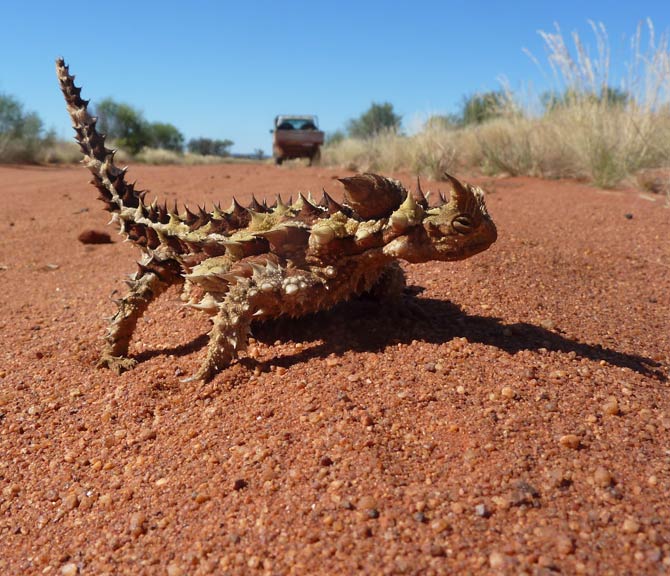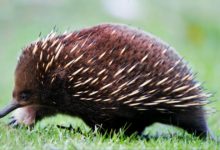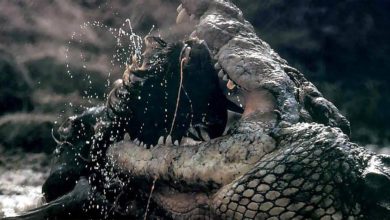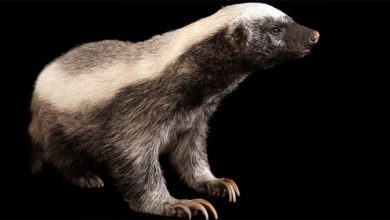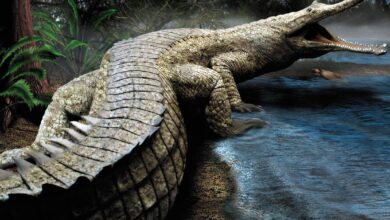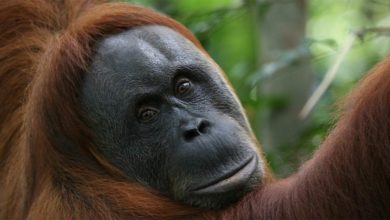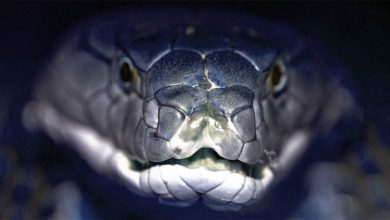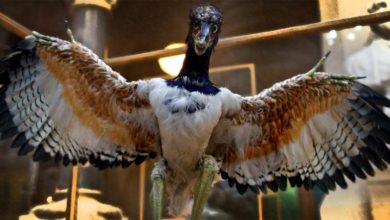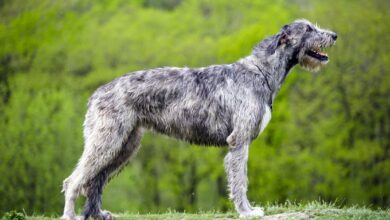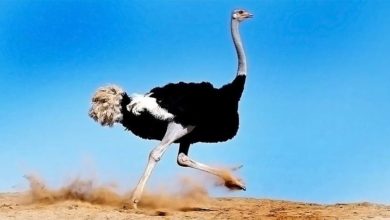Mountain devil, thorny lizard, thorny dragon, moloch
A true monster of the Australian deserts, scaring off large and small predators with its appearance. Sounds scary, doesn’t it? However, we are not talking about the dragon from Tolkien’s works, but about a 20-centimeter (7.9 in) horned lizard, whose greatest weapon is to deceive intruders. Let’s have a closer look at the “terrible monster”.
Classification
- Kingdom: Animalia
- Phylum: Chordata
- Class: Reptilia
- Order: Squamata
- Suborder: Iguania
- Family: Agamidae
- Subfamily: Amphibolurinae
- Genus: Moloch
- Species: Moloch horridus
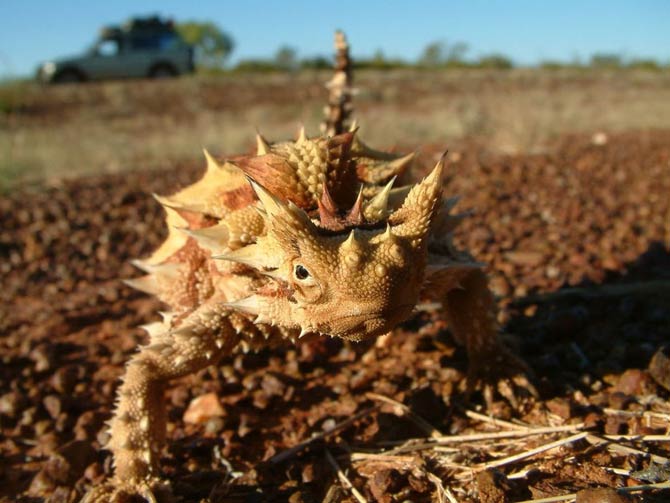
Name
The lizard’s name reflects its physiognomy: the two horns on the top of its flattened head give it a dragon-like appearance. In the past, Moloch was used to refer to deities of the ancient Near East to whom children were to be sacrificed. With time, however, it began to be used in demonology as the name of the fallen angel, the prince of hell.
This animal was first described in 1841 by the biologist John Edward Gray did it. Although this lizard is the only representative of the genus Moloch, some scientists are looking for its closest relatives. Probably its distant cousin are the North American lizards of the genus Phrynosoma (horned lizards), belonging to the Phrynosomatidae family. However, it is believed that the similarity between these reptiles is due to convergent evolution.
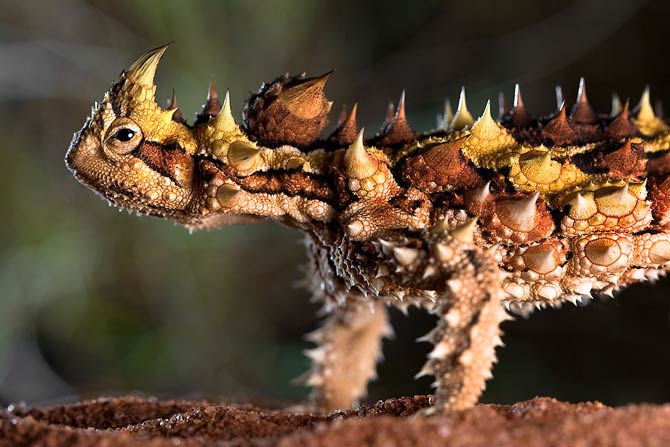
Occurrence
It occurs only on the Australian continent. Most of the population lives in Central and Western Australia. It chooses bush and desert habitats that cover most of central Australia. The thorny devil is quite common among the Triodia grasses and in the Mallee biogeographical area in the west of the country.
It seems that the “terrible behemoth” does not choose a habitat in terms of climate, but rather in terms of soil type – it is most often found in sandy, dry areas.
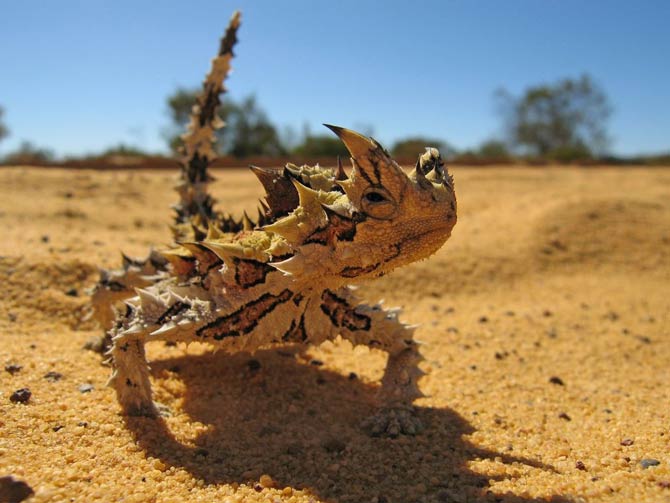
Characteristic
Appearance
Despite its disturbing name, the “terrible behemoth” is a small animal, but it stands out from other inhabitants of Australian deserts. It measures an average of 20 cm (7.9 in) in length and weighs as much as an average size mouse.
This lizard is known for its spiky armor resembling a dragon or … a devil.
The longest spines grow on the head and torso, slightly smaller skin formation can be noticed on the limbs and abdomen. The body of the thorny devil is strongly hardened and therefore stiff, so the thorny devil moves slowly. Due to the specific structure of the armor, it can collect rainwater that falls between the spikes and flows down through special channels to the corners of the mouth. Thanks to its tongue, the reptile can lick it freely.
As with many other lizards, female juggernauts are larger than males and have a lighter carapace. On the other hand, rusty red is often dominant on the male body. In warm weather, the skin is usually pale yellow or red in color. In a cool morning, the armor is saturated with grays, dirty green and white.
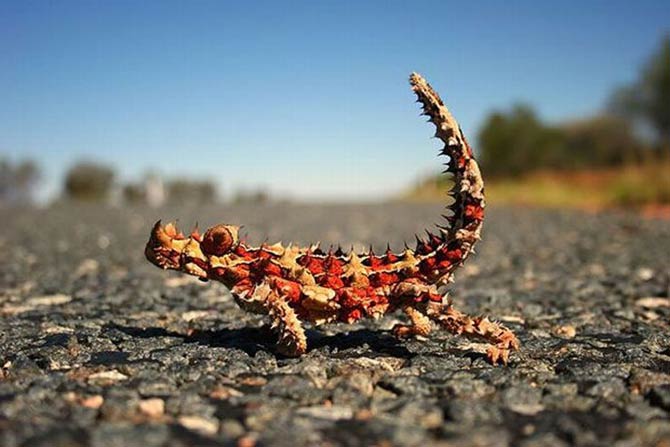
Color change and a fake… head
Regardless of gender, however, the reptile’s body turns pale in the sun and darkens when it cools in the shade or when it is disturbed. There is a so-called false head, the task of which is to distract a predator. When the juggernaut notices the intruder, it lowers its real head between its front paws to show the back one and thus focuses the opponent’s attention on the “dummy”. Thanks to this, in the event of an attack, the animal can save its real head. Well, everyone has their own way of covering their head – an ostrich hides it, for example, in the sand 🙂
In defense against predators, it is also helped by spikes and a specific, slow gait, during which the animal sways back and forth alternately, and then freezes. The spikes discourage an attacker from attacking because this type of victim is difficult to swallow. Nevertheless, the thorny devil falls prey to birds of prey and Australian varans (Perentie).

Lifestyle
Diet
The thorny devil is specialized in catching ants, mainly of the genus Iridomyrmex and Ochetellus. In one day, he can eat several thousand of them. It hunts for them during the day, when they are most active. He himself is not a very active hunter – he just waits for these insects to appear at the feeding site and then grabs them with his sticky tongue. Moloch’s teeth are designed to crush hard, chitinous shells. Often, however, in the characteristic feces of this lizard, you can see small ant skeletons.
In addition to food, the thorny devil needs to get water. However, this is not a problem for him, because all over the body, between the spines, there are special channels that drain rain or ground water to the mouth. At night, it collects water from the dew, so there are no problems with the deficit of life-giving fluid, even in desert areas.
Reproduction
Breeding takes place in spring and summer, i.e. from September to December. During this time, females lay 3-10 eggs in burrows located about 30 cm (12 in) underground. The young hatch after 3-4 months and are approx. 4 cm (1.6 in) long.
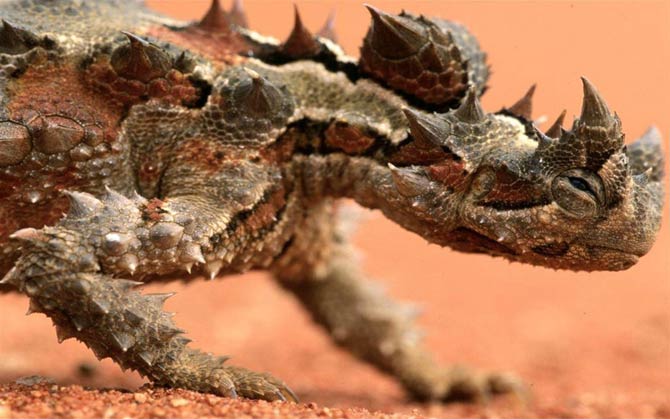
Detailed data and dimensions (size)
Thorny devil (Moloch horridus)
- Body length: 15-21 cm (5.9 – 8.3 in), females are larger than males
- Weight: 70-95 g (females are heavier than males)
- Lifespan: 15-20 years
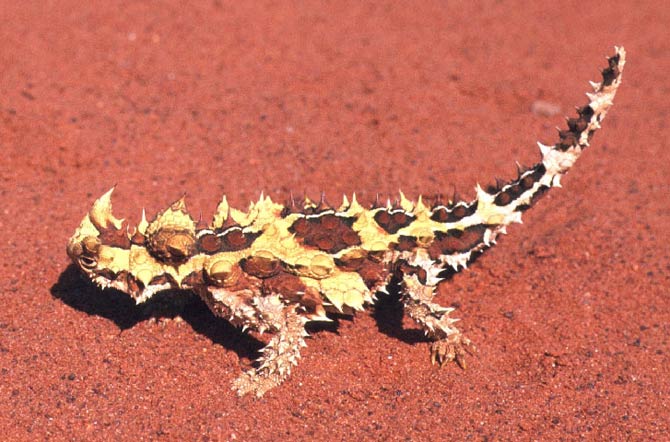
Thorny devil – interesting facts
- The thorny devil can inflate its body to enlarge its size. Thanks to this, the predator has problems swallowing it.
- Although the thorny devil lives in deserts, it does not like extreme temperatures. During the greatest heat waves (January – February) and frosts (June – July), it is practically inactive – it spends most of its time in an underground burrow.
- The water-storing channels on the moloch’s body are hygroscopic. This means that they are susceptible to absorbing moisture from various sources, e.g. morning fog, dew or rain.
- Although the thorny devil can be bred in a terrarium, it is an extremely difficult task due to, among others, nutritional needs. Moreover, this animal is virtually impossible to obtain outside of Australia.
